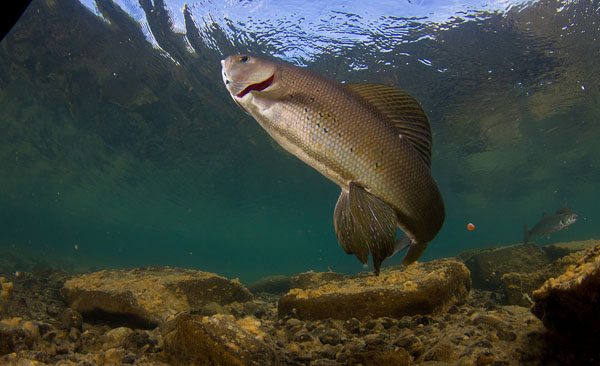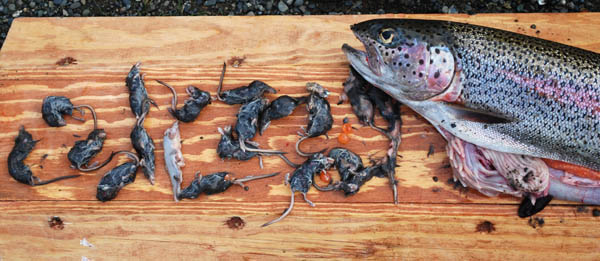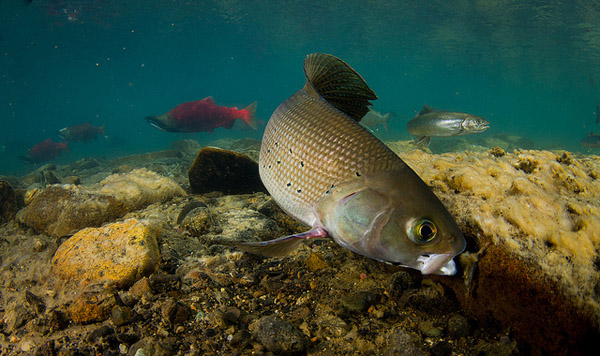 |
Canku Ota
|
 |
|
(Many Paths)
|
||
|
An Online Newsletter
Celebrating Native America
|
||
|
November 2014 - Volume
12 Number 11
|
||
|
|
||
|
Big Gulp: How Often
Do Trout and Grayling Eat Mammals?
|
||
|
by Matt Miller, senior
science writer, The Nature Conservancy
|
||
A shrew, hunting insects along a stream bank, slips into the icy water. It swims frantically to reach shore, using all its energy to stay afloat. Just as it appears the small critter might make it, an almost imperceptible ripple appears. And then the water explodes. The surface soon calms, but the shrew is gone. Trout food. Variations on this theme are favorites in fishing lore, and there are plenty of photos that prove this does actually occur. But how frequently? A new article appearing in the journal Ecology of Freshwater Fish suggests this answer: more often than you think. The paper – by coauthors Peter Lisi, Kale Bentley, Jonathan Armstrong and Daniel Schindler – documents the incidence of rainbow trout and grayling over a 13-year period in the Wood River basin, part of the Bristol Bay watershed in Alaska. The Shrew Hatch
Incidences like this are often reported as isolated and opportunistic. Big trout will gulp down a vole or shrew if one falls in, but mammals haven’t been considered a major part of the diet. This study documents that rainbow trout and grayling actually key in on shrews every two to three years when the mammals may be at peak abundance, much as trout will focus on mayflies or caddis flies when these insects hatch. The small mammals could provide important nutritional value to fish. In peak years, about 25 percent of rainbow trout and grayling larger than 12 inches had eaten the small mammals. Peter Lisi, lead author of the study, was working on other fish research while completing his doctorate under Daniel Schindler at the University of Washington (Lisi is now a post-doctoral fellow at the University of Wisconsin-Madison). The researchers kept finding trout and grayling with shrews in their stomachs. They wondered how often this actually occurred.
“It became a side research project, something we did out of scientific curiosity,” Lisi says. “How often do these mammals end up in the water? How often do fish eat them? It turns out that every few years in the Wood River basin, trout key in on shrews.” Shrews are insectivorous mammals that are known to have boom and bust cycles. The researchers speculate that in years of peak abundance, trout and grayling eat them in significant numbers. “Fish are good at selecting rich prey sources,” says Lisi. “Fly fishers know this well. During a mayfly hatch, if you don’t have the right fly, you’re not going to catch anything, because trout are all focused on a very specific insect.” How do the shrews wind up in the water? Lisi notes that researchers can only speculate at this point, especially since (unlike trout) shrews are under-studied animals. A couple of common explanations can be ruled out. In the Wood River basin, the phenomenon does not appear to be associated with flooding, where small mammals are washed into the stream with heavy rain. There is a species of water shrew that swims and hunts aquatic prey, but this species is not found in the Bristol Bay region. In this case, the predation may simply come down to abundant prey near the water. Lisi notes that they observed some years when shrews were abundant, and that it seemed that during these times shrews were very active along stream banks. The shrews are likely hunting insects and other prey. “Shrews have a high metabolism, so they have to eat frequently,” Lisi says. “When there are so many shrews, it might lead some to take chances, to hunt close to the edge of the stream or even wade into the stream for aquatic insects.” The researchers saw shrews crossing very small streams, although some fishing guides have reported that these animals don’t swim very well, making them easier prey for trout. “Given the incidence of predation we saw, it’s highly doubtful any shrew could make it across a large river,” says Lisi. One intriguing possibility is that trout also pull shrews off banks, like the orcas that attack seals on beaches in Argentina, or the video-documented cases of catfish lunging for pigeons along water’s edge in France. Do trout hunt prey in this way? If you’ve seen it, I’d love to hear about it. Big Fish, Big Prey
Not all rainbow trout and grayling eat shrews. In part, this is simply because not all trout and grayling can even fit a mammal into their mouths. Lisi reports that it takes a 12-inch grayling to eat a shrew. But not all 12-inch grayling eat mammals. Lisi reports that they surveyed grayling in pools where a 12-inch fish was the largest in the pool, and that fish had shrews in its stomach. Other waters had pools full of 12-inch fish but also contained some larger fish. In these situations, it was only the larger fish that had grayling in their stomach – not the twelve inchers. “This suggests interesting social dynamics going on here,” says Lisi. “The biggest grayling are excluding the others from eating shrews, and capitalizing on that resource. Often the largest fish had as many as six shrews in their stomachs.” How often does this occur outside Bristol Bay? There are a lot of reports of fish eating mammals, including trout eating multiple voles at Idaho’s Silver Creek, also covered in a previous blog. In Mongolia, taimen have been found with more than 40 lemmings in their stomachs. That’s right: forty. But even for highly studied species like trout, there’s a lot we don’t know. Observations by anglers can help a lot in understanding fish ecology and behavior. Detailed scientific studies occurring over a period of years offer the most valid information — particularly when those studies occur in a healthy, intact ecosystem like Bristol Bay. There are a number of other studies coming out of Bristol Bay that could shed new light on fish behavior and ecology. I’ll report on more of these findings in the coming months. In the meantime, keep those stories of “what the trout eats” coming. The paper: Lisi, P. J., Bentley, K. T., Armstrong, J. B. and Schindler, D. E. (2014), Episodic predation of mammals by stream fishes in a boreal river basin. Ecology of Freshwater Fish, 23: 622–630. doi: 10.1111/eff.12117 Opinions expressed on Cool Green Science and in any corresponding comments are the personal opinions of the original authors and do not necessarily reflect the views of The Nature Conservancy.
|
||||||||
|
|
||
|
|
||
| Canku Ota is a free Newsletter celebrating Native America, its traditions and accomplishments . We do not provide subscriber or visitor names to anyone. Some articles presented in Canku Ota may contain copyright material. We have received appropriate permissions for republishing any articles. Material appearing here is distributed without profit or monetary gain to those who have expressed an interest. This is in accordance with Title 17 U.S.C. Section 107. | ||
|
Canku Ota is a copyright ©
2000 - 2014 of Vicki Williams Barry and Paul Barry.
|
||
 |
 |
|
|
The "Canku
Ota - A Newsletter Celebrating Native America" web site and
its design is the
|
||
|
Copyright ©
1999 - 2014 of Paul C. Barry.
|
||
|
All Rights Reserved.
|
||




 Matt
Miller
Matt
Miller